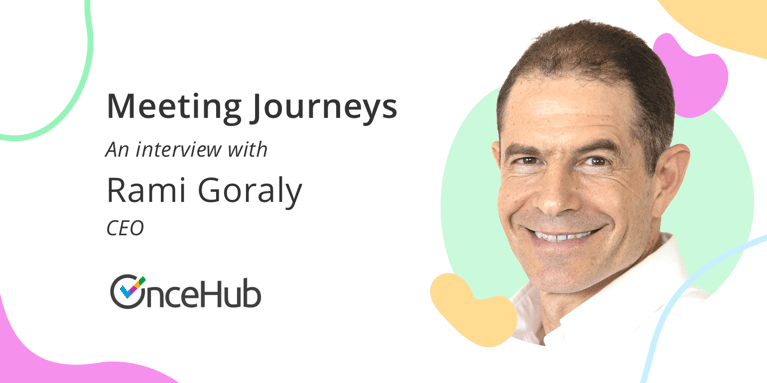The Future of Instant Meeting Software & Scheduling: Trends and Predictions

With the rise of remote work and the need for efficient virtual collaboration, instant meeting software has become an essential tool for businesses worldwide. In this interview, we will delve into the future of instant scheduling and its role in shaping the way we work and communicate. So let's dive in and hear from the man at the helm of OnceHub, Rami Goraly.
When OnceHub was still in its infancy, what motivated you to get started in the scheduling business?
Scheduling software in any way, shape or form was really only used by service businesses that were selling their time, like salons and spas. The thinking was that there are all these calendar suites like Outlook and Google facilitating internal meetings but the solution did nothing for engaging outside of your organization.
So we started thinking of ways to set up scheduling infrastructure that could be used by anyone. We were not the only people with this idea but whereas other similar products took up VC-backed funding and spent millions on marketing noise, we stuck to a product-led approach and grew our offering into what it is today.
What was the general attitude toward concepts like scheduling links and booking pages?
It was considered very rude and there was a clear power play perceived by people on the receiving end of a link to a booking page. Other startups in the schedule space back in 2006 and 2007 spent enormous amounts of money to improve the perception of the idea of a booking link, which turned out to be a huge waste of money as the market just was not ready.
While it is considerably less so now, you really do still have to be mindful of how you are communicating and be sensitive to perceptions as this can affect relationships and prospects going forward.
In the innovation era, disruption is pretty much a given. What would you say have been some of the more dramatic evolutions the scheduling market has witnessed?
The biggest change to the market to date was the mass adoption of mobile smartphones. Suddenly it wasn’t a problem that you didn’t want to talk to people and deal with calls and appointments head on. With information and options presented virtually in your hand you could be very selective about when and how you wish to engage with a person or an organization.
This inflection point occurred around 2013 and suddenly it was completely socially acceptable, at least in some sectors of the population, to conduct their affairs almost entirely via your phone.
Following the pandemic and the normalization of virtual meetings and remote work, what is the biggest change you’ve seen in how people approach digital interaction and engagements?
Whereas before virtual meetings were an option, it is now the default. Even service industries now approach prospects virtually before creating opportunities for additional engagements.
The Workplace of the Future seems to always be a topical conversation as we engage with concepts like the metaverse, hybridity and digital watercooler moments. How do you think scheduling and instant meetings can influence this?
I think if organizations make use of scheduling software to conduct watercooler moments that they’re probably very bad at communicating. For external use, sure, but there should be a more natural and spontaneous way to have these interactions via Teams and Slack for example.
In the virtual workplace we are getting very used to jumping on instant calls. Could this become the norm with people outside your organization and what would some of the challenges be of a Meet Now paradigm that has more similarity with a phone call than a scheduling infrastructure?
Before the widespread adoption of scheduling software, the main way to contact an organization was by phone call, but this did not necessarily mean it was instant. Sometimes you would be routed through a call center, a switchboard or you would have to attempt contact a few times before getting through.
Now, scheduling and instant meetings work in tandem. By utilizing both and knowing when to action either you give people options and increase your opportunities for engagement.
How would you define instant meetings and what are the most powerful applications of it?
Instant meetings are relatively new and underutilized at present. I think contact centers are more prevalent than instant meetings at this point. In our context, instant meetings are engagements that can be initiated instantly via your booking page or after a series of questions you pose for routing purposes.
Today, people are not willing to wait so it is advantageous to connect at the right time. For some engagements, a buffer can help and scheduling allows for preparation. In most cases now, it is better to reduce waiting and secure opportunities for conversion immediately.
As someone who has helped shape the scheduling narrative, do you think there is a next big thing looming that will bring dramatic change?
As booking pages and calendar invites are now socially acceptable, we see the need for more meetings with more context and more qualification.
Everyone who is in the meeting business has a desire for context so they can maximize conversion. They drive their businesses by talking and engaging so they need to improve both the quality and the quantity of these meetings.
So what you do is you present people with options to engage before they churn and go somewhere else and you qualify them so you can have better meetings with them.
Lastly, give us a hot take on something that you personally find annoying about meetings?
I'm not too fond of unproductive meetings. Especially when I meet people for the first time, I always think that a structured context creation before any meeting (mutual qualification and preparation) could make us all more effective in conducting business.
Better scheduling starts here
No credit card required